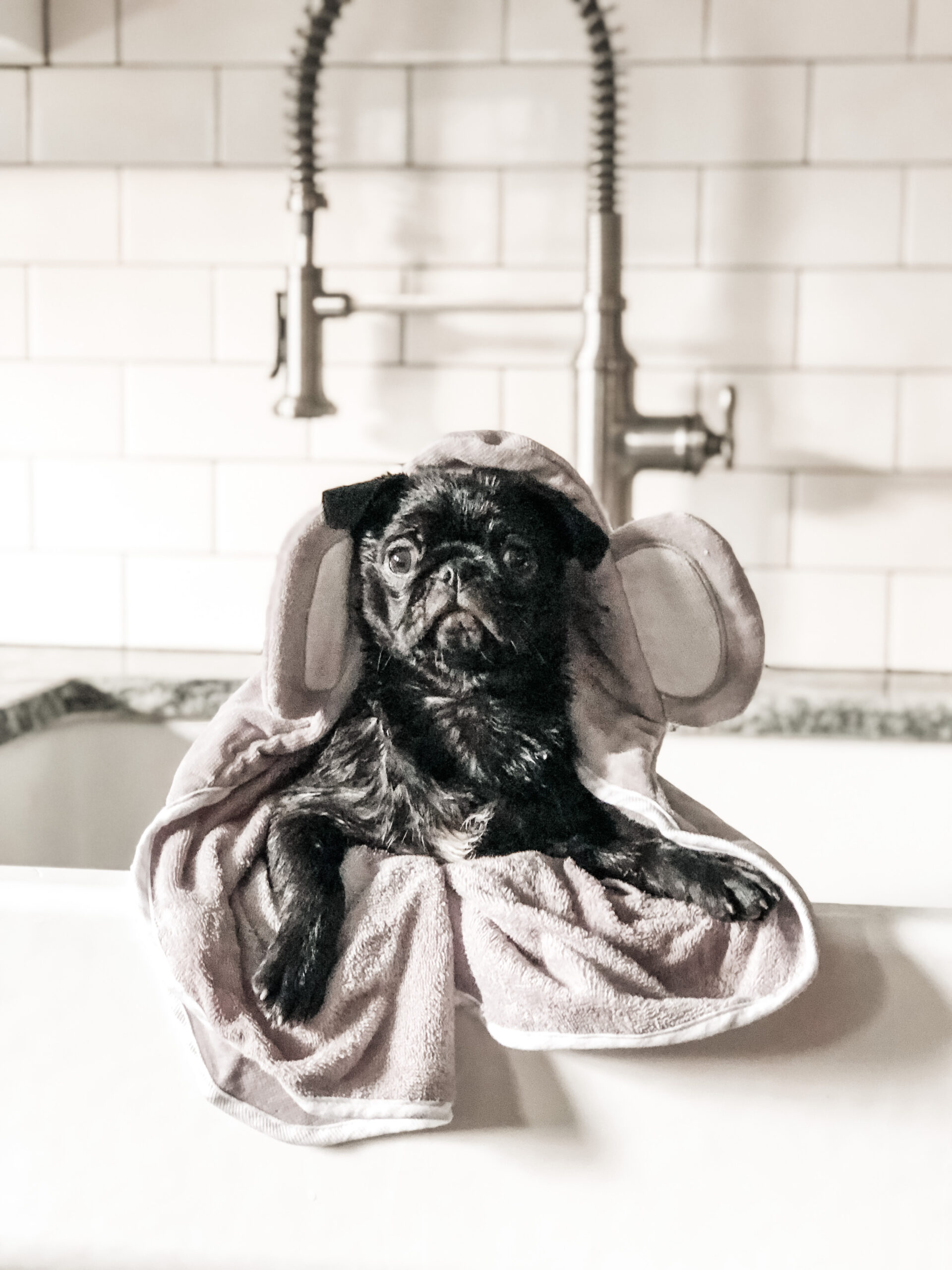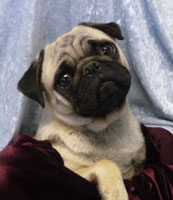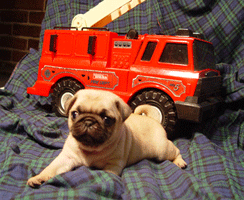Pug Health
Despite their extreme facial shapes and body modification caused by hundreds of generations of selective breeding, well-bred pugs remain basically healthy little dogs. Below you will find brief discussions of various pug health issues that you can help to prevent in your own pug. Ugly Mugs pugs come with a health guarantee listing a number of specific genetic defects that are covered if you have maintained your pug in good health. For a more extensive discussion of pug health issues, talk to your veterinarian or search the internet.
Spaying and neutering
The most important thing you can do to protect your pug’s health is to spay or neuter your pet!! Contrary to a common folktale, spaying and neutering do not make dogs fat. Overfeeding makes dogs fat!
Unaltered pets are at far greater risk for cancer. They are also at far greater risk of ending up in an animal shelter. Why? Because unaltered dogs are inferior pets! Pugs can be challenging to house train in the first place. Unaltered pugs are almost impossible to persuade not to urinate in your home. Unaltered dogs can be moody when they are in season, in the case of un-spayed females, or obnoxious and hyperactive most of the time, in the case of un-neutered males.
Unspayed females come into heat about every six months. During this time, your pug girl can become extremely temperamental, and even snappy with her own family, children, and other pets. When in season she will drip blood for up to two weeks, staining and soiling everything she sits or lies on as well as all of your floors. She may even start peeing indoors, marking objects like an unneutered male! Unspayed females are vulnerable to various forms of cancer, which are often fatal.
Unneutered males often make very unsatisfactory pets. Almost all intact males can never be truly housebroken. They will instinctively mark new objects, indoors and out. Some unneutered males are hyperactive (especially in the presence of female dogs!) and many are far less loving, patient, and attentive than their neutered counterparts. They are prone to testicular cancer.
But what if we want to breed our pug?
Breeding pugs is not to be taken lightly, and generally is not a good idea for amateur or inexperienced breeders. The mortality rate of both mother and puppies in this breed is devastatingly high, even when supervised round the clock by experienced humans with all of the right training and equipment. If you are not home 24 hours a day and fully prepared for a Cesarean section, an entire litter of dead and/or brain damaged puppies, and even the loss of your very own pug girl, you should not even consider breeding your pug.
Obesity
Pugs get fat easily. Between their natural gluttony, cobby little bodies, and limited taste for exercise, it’s no wonder! It is our duty as pug owners to help them retain their figures. Do not expect them to thank you for your watchful care!
Overweight pugs can fall victim to a whole spectrum of illnesses and ailments. Please note that failing to maintain your pug at a healthy body condition will invalidate the health guarantee that come with Ugly Mugs pug puppies. Fat pugs are prone to heat stroke, hyperthermia, heart disease, arthritis, and back and joint problems.
Many adult pugs will require reduced calorie dog food. Feed a high quality brand – look for meat as the first ingredient listed. It is important to feed no more than is recommended. You should be able to see a ‘waistline’ looking at your pug from above, and feel the ribs fairly easily. Contrary to what your pug is sure to tell you, you are not doing him a kindness by feeding him people food or table scraps.
Heat Intolerance
Most dog lovers will naturally infer that a toy dog has no business spending a lot of time outdoors if it is very cold. This is especially true for pugs, as their extremely short nasal passages cannot sufficiently warm frigid air before it enters the lungs.
Just as important is protecting your pug from overheating. Pugs can and do die from heat stroke and hyperthermia. Pugs simply cannot be left out in the sun. Black pugs must be watched diligently and provided with shade at all times. In high temperatures, a pug’s proper place is indoors in the air conditioning.
Respiratory Problems
Many pugs are afflicted with Stenotic Nares (undersized nostrils) and / or an elongated soft palate. Either condition causes breathing difficulties, and can be corrected surgically. Both are covered in our puppy health guarantee Responsible breeders do not breed dogs showing tendencies toward either condition!
Difficulty breathing is probably the most common pug health problem. Overweight or overheated pugs can usually be heard gasping for breath. Some pugs have allergies and need antihistamine medication. Pugs are not suitable pets for people who smoke cigarettes indoors. Monitor your pug’s breathing and give him the extra care the breed needs. Pugs are family dogs, but they are not jogging companions.
Vulnerable Eyes
Large, expressive pug eyes are always at risk for damage. Corneal ulcers (scratches on the surface of the eye) can occur easily. Protect your pug from unfriendly cats and be careful when walking through deep grass or brush with your pug. Keep his nails trimmed short and smooth. If your pug’s eyes look red, irritated, or weepy, consult your veterinarian.
Urinary Tract Infections
Pugs’ short urethras predispose them to urinary tract infections. Common symptoms are blood in the urine and a housetrained pug that suddenly begins wetting indoors. Consult your veterinarian if you suspect an urinary tract infections. We give cranberry juice to pugs who suffer repeated infections, as the acidity seems to help. If you choose to mix cranberry juice into your pug’s water, make sure you choose a brand that is not saturated with corn syrup or sugar.
Orthopedic Issues
Many purebred breeds of dogs are now genetically predisposed to some very serious leg and knee problems. Hip dysplasia, patellar luxation, and Legg-Calve-Perthes Disease have all been identified in pugs. To learn more about these diseases, visit the Orthopedic Foundation for Animals website. Responsible breeders are very careful to watch their stock for any sign of orthopedic problems, and do not breed lame dogs! Interestingly, it has been discovered that many pugs have clinical hip dysplasia, but are not bothered by their conditions. Just to be sure, we include full coverage for all three conditions in our puppy health guarantee.
Skin Problems
Many lines of pugs bred for the show ring suffer from Demodectic Mange and auto immune disorders affecting the skin. These conditions are far less common in pugs who have not been so closely line bred. Pug lovers considering purchasing a line bred pup with show potential should inquire closely about the skin health of its relatives.
The AKC show standard calls for very deep wrinkles on a pug’s face. Some individuals need their people to clean the wrinkles using a q-tip or cotton swab on a regular basis or infections can develop. Ugly Mugs pugs’ wrinkles tend to be more moderate and do not require extra care unless the pug’s entire face is very dirty.
Pug Dog Encephalitis
An often deadly inflammatory brain disease, PDE causes seizures in its victims. Always bring your pug to the vet if you know or even suspect that he is having seizures!



